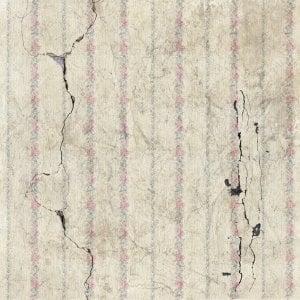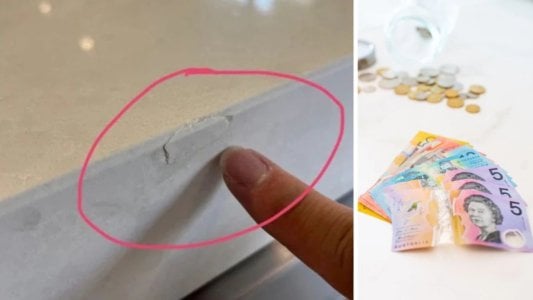Aussie tenant fights back as real estate agent charges $550 for repairs
When renting property, you should know your rights and duties. So, if you feel your landlord is asking too much money for mere damages, you need to do something about it!
Case in point: an Australian renter was charged $550 for a minor chip in the kitchen benchtop of her former flat—a request that seemed a little too high for supposed natural ‘wear and tear’.
The woman shared a picture of the benchtop taken two weeks post-move on social media, with the image distinctly displaying the minor chip.
She then mentioned that the damage was due to her partner accidentally dropping a ‘Pyrex bowl’.
‘The quote they gave me just seemed unusually high. I’ve gotten two separate quotes now, with the lowest being $286. It just seems they’re pulling numbers out of their a**.’
The woman further shared that her agent sent her the original repair quote in an informal email.
Although she was willing to get the damage fixed, she worried there was no official bill or proof of the repair.
Moreover, the agent had requested to withdraw their bond claim.
She sought advice on the best course of action without overpaying for the damage.
What is considered ‘fair wear and tear’ in rentals?
In Australia, rental properties account for ‘wear and tear’ due to ageing and regular use.
Tenants Victoria states renters and their guests shouldn't cause intentional or negligent damage to the property or common areas, but instances of fair ‘wear and tear’ are not considered this type of damage.
However, several factors can influence the distinction between ‘wear and tear’ and damage, including the length of the tenant’s residency and the age, extent, and location of the affected area.
In most cases, the difference depends on typical usage. If items degrade naturally due to regular use, they are typically categorised as fair wear and tear.

‘For example, minor scuff marks on walls or floors, marks caused by foot traffic on carpets, or worn and faded curtains or blinds are all considered fair wear and tear under the Consumer Affairs Victoria guidelines.’
How to dispute property damage claims
When dealing with disputes as a tenant, start by thoroughly reviewing your lease agreement.
Pay close attention to sections concerning property condition, maintenance, and tenant responsibilities.
Document any damage with clear, dated photos or videos, including pre-existing issues and the specific damage in question—this will serve as key evidence.
Communicate with your real estate agent (through a letter or an email), outlining why the repair bill is unreasonable and asserting your tenant rights.
Always try to negotiate a more reasonable cost or a 50/50 cost-sharing arrangement.
If negotiations fail, consider applying to the tribunal to dispute the repair cost, especially if it conflicts with your weekly rent.
In complex or contentious situations, seeking legal advice or assistance from a tenant's advocacy organisation can be beneficial.

Members, if you were the renter in this story, how would you feel about spending $550 for wear and tear repairs? And speaking of wear and tear, how do you define it from your own perspective? Share your insights and opinions in the comments below—we’re all ears!
Case in point: an Australian renter was charged $550 for a minor chip in the kitchen benchtop of her former flat—a request that seemed a little too high for supposed natural ‘wear and tear’.
The woman shared a picture of the benchtop taken two weeks post-move on social media, with the image distinctly displaying the minor chip.
She then mentioned that the damage was due to her partner accidentally dropping a ‘Pyrex bowl’.
‘The quote they gave me just seemed unusually high. I’ve gotten two separate quotes now, with the lowest being $286. It just seems they’re pulling numbers out of their a**.’
The woman further shared that her agent sent her the original repair quote in an informal email.
Although she was willing to get the damage fixed, she worried there was no official bill or proof of the repair.
Moreover, the agent had requested to withdraw their bond claim.
She sought advice on the best course of action without overpaying for the damage.
What is considered ‘fair wear and tear’ in rentals?
In Australia, rental properties account for ‘wear and tear’ due to ageing and regular use.
Tenants Victoria states renters and their guests shouldn't cause intentional or negligent damage to the property or common areas, but instances of fair ‘wear and tear’ are not considered this type of damage.
However, several factors can influence the distinction between ‘wear and tear’ and damage, including the length of the tenant’s residency and the age, extent, and location of the affected area.
In most cases, the difference depends on typical usage. If items degrade naturally due to regular use, they are typically categorised as fair wear and tear.

As per Consumer Affairs Victoria, renters are not authorised to arrange and cover the expenses of urgent repairs exceeding $2500. Image source: Pixabay
‘For example, minor scuff marks on walls or floors, marks caused by foot traffic on carpets, or worn and faded curtains or blinds are all considered fair wear and tear under the Consumer Affairs Victoria guidelines.’
How to dispute property damage claims
When dealing with disputes as a tenant, start by thoroughly reviewing your lease agreement.
Pay close attention to sections concerning property condition, maintenance, and tenant responsibilities.
Document any damage with clear, dated photos or videos, including pre-existing issues and the specific damage in question—this will serve as key evidence.
Communicate with your real estate agent (through a letter or an email), outlining why the repair bill is unreasonable and asserting your tenant rights.
Always try to negotiate a more reasonable cost or a 50/50 cost-sharing arrangement.
If negotiations fail, consider applying to the tribunal to dispute the repair cost, especially if it conflicts with your weekly rent.
In complex or contentious situations, seeking legal advice or assistance from a tenant's advocacy organisation can be beneficial.
Key Takeaways
- An Aussie tenant is disputing a $550 repair bill for a minor chip in her kitchen benchtop, claiming that the cost is too high for the level of damage.
- The issue has reopened discussions on what constitutes fair wear and tear in a rental property, with the tenant also criticising the lack of an invoice or proof of repair.
- According to Tenants Victoria, damage does not include fair wear and tear, but the definition of these terms can vary depending on several aspects, such as the property's age, the damage's size, and its location.
- For tenants in a similar situation, understanding lease terms, documenting the damage, negotiating for an acceptable cost, and seeking legal advice are recommended steps to handle potential disputes.








